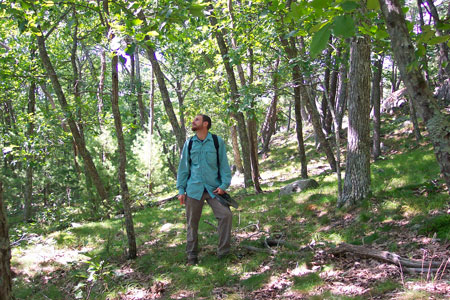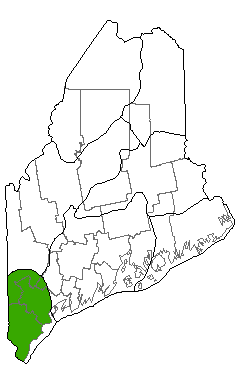DACF Home → Bureaus & Programs → Maine Natural Areas Program → Communities, Plants, and Animals → Natural Community Fact Sheets → Chestnut Oak Woodland
Printer Friendly Fact Sheet - 1.1 MB pdf (Get a free copy of Adobe Acrobat Reader)
Chestnut Oak Woodland
Scientific Name: Chestnut Oak Woodland; State Rank: S1

- Community Description
- Soil and Site Characteristics
- Diagnostics
- Similar Types
- Conservation, Wildlife and Management Considerations
- Distribution
- Characteristic Plants
- Associated Rare Plants
- Associated Rare Animals
- Examples on Conservation Lands You Can Visit
Community Description: This partial canopy woodland type is dominated by chestnut oak in association with other oak species, white pine, and rarely shagbark hickory. The sapling layer typically includes small oaks as well as various shrub species. Beneath the trees, a mixture of low heath shrubs and herbs covers much of the ground surface, with some bare rock patches. Bracken fern and lowbush blueberry are most common. Bryoids are virtually absent. Back to top.
Soil and Site Characteristics: These woodlands occupy dry ridges and south facing slopes on thin, excessively well drained and stony soils. Known sites are in extreme southern Maine only, on granite-syenite bedrock. Back to top.
Diagnostics: These woodlands (25 to 65% canopy cover) are dominated by chestnut oak. Back to top.
Similar Types: Other hardwood forest types are dominated by trees other than chestnut oak. Back to top.
Conservation, Wildlife and Management Considerations: The single documented site in Maine is in public ownership, with attention given to conserving this rare type. In other parts of the range of this type, fire appears to have played a role in preventing the invasion of fire sensitive hardwood trees and shrubs. The suppression of fire could therefore result in the gradual conversion of these woodlands to a more mesic oak-pine type. In Maine, chestnut oak does not seem to regenerate well under its own canopy.
Mature occurrences of this type offer excellent potential sites for cavity dwellers such as the southern flying squirrel. Back to top.
Distribution: Characteristic of the Eastern Broadleaf Forest Province, extending southward and southwestward from Maine and only barely reaching into the state. Landscape Pattern: Small to Large Patch in Maine; matrix-forming further south. Back to top.


Characteristic Plants: These plants are frequently found in this community type. Those with an asterisk are often diagnostic of this community.
- Canopy
- Black cherry
- Chestnut oak*
- Red maple
- Red oak
- White oak
- White pine
- Sapling/shrub
- Black huckleberry
- Maple-leaved viburnum
- Meadowsweet
- Shadbush
- Witch-hazel
- Dwarf Shrub
- Lowbush blueberry*
- Velvet-leaf blueberry
- Herb
- Bracken fern*
- Common hairgrass
- Partridgeberry
- Rough-leaved ricegrass
- Wild-oats
- Wintergreen
- Woodland sedge
- Bryoid
- Hair cap moss
- Red-winged sallow
- Whip-poor-will
Examples on Conservation Lands You Can Visit
| Example | County |
|---|---|
| Mt Agamenticus | York Co. |